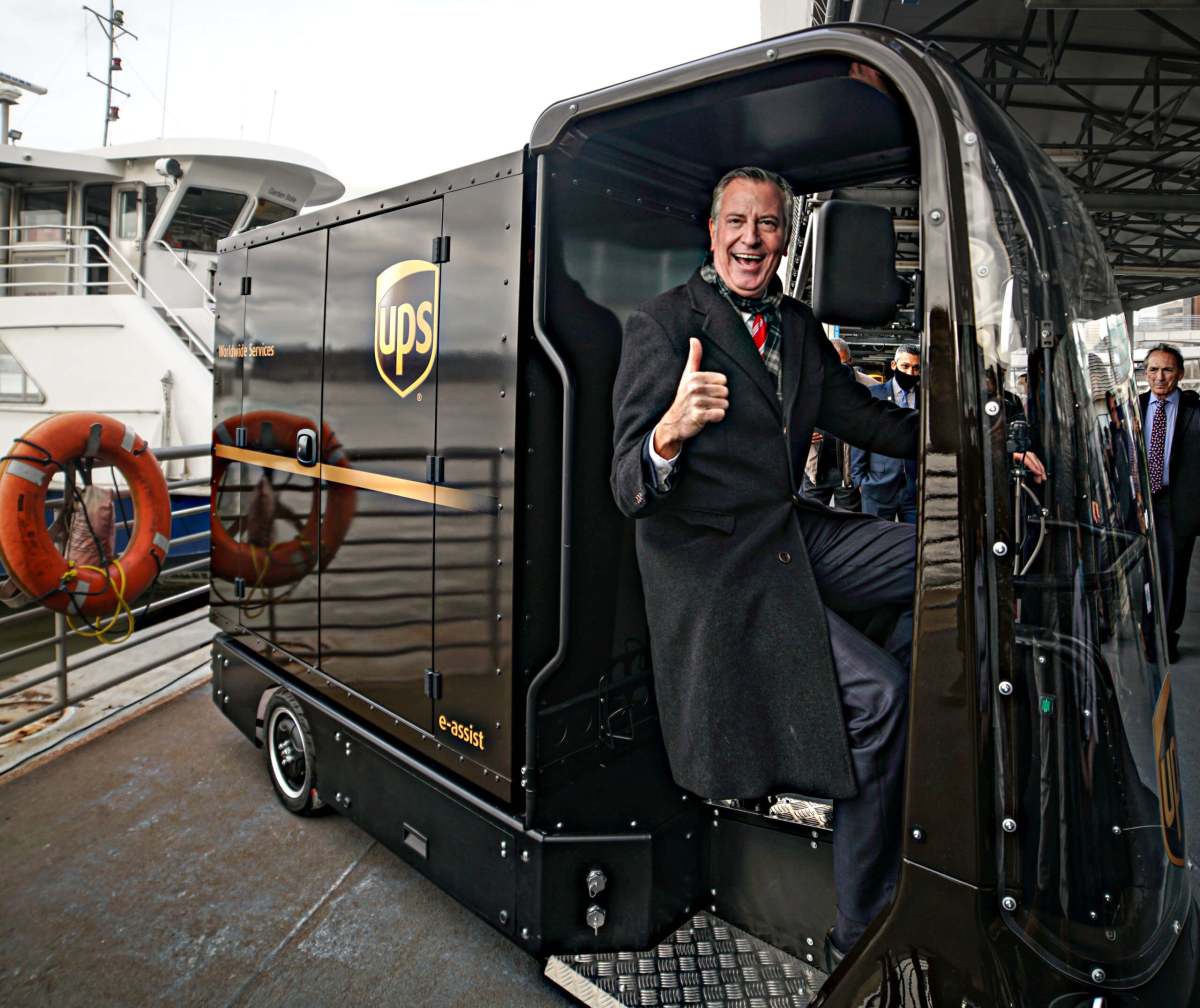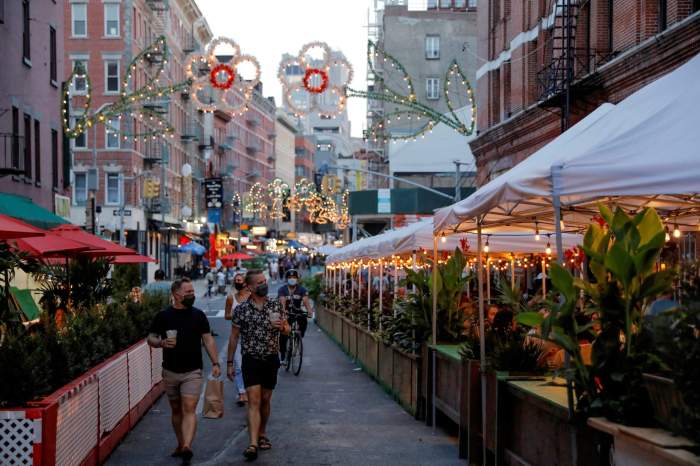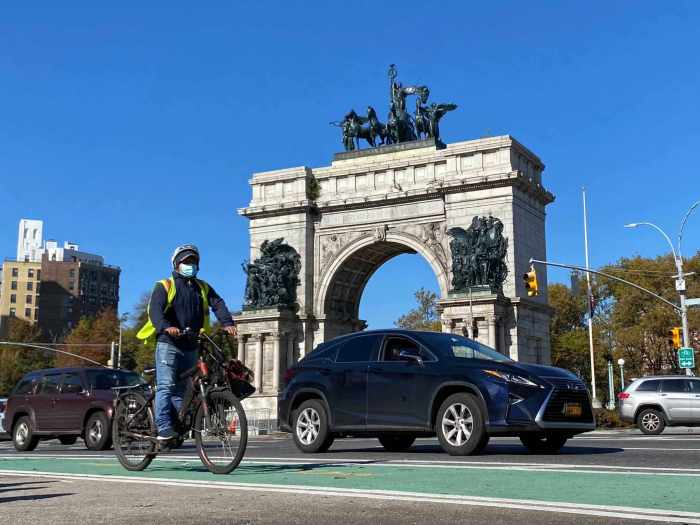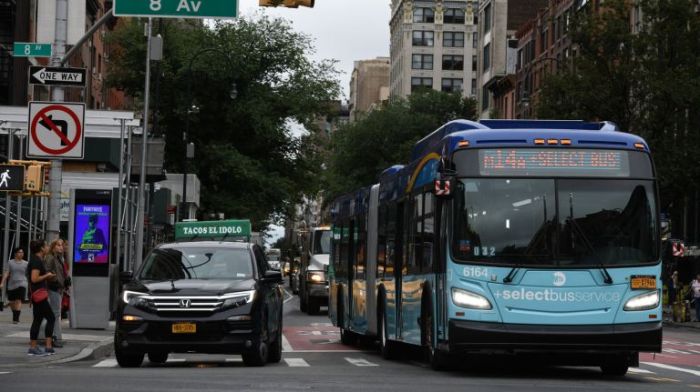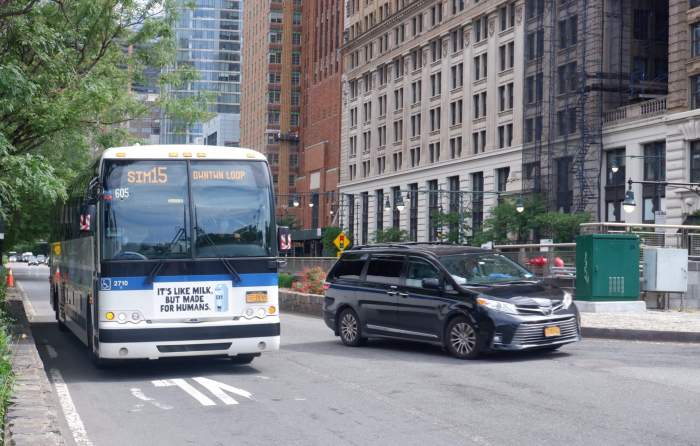City officials released a framework Wednesday for how to make freight shipping in the Five Boroughs more environmentally friendly by moving more goods on boats, trains, and bikes rather than trucks.
The “Delivering Green” proposal by the Department of Transportation and the quasi-public Economic Development Corporation — which was first reported by amNewYork Metro — lays out five goals for the incoming Mayor Eric Adams administration to reduce the Big Apple’s reliance on gas-guzzling heavy-haulers.
“One of the best ways to fight climate change is to get away from a society and an economy dominated by big trucks,” said outgoing Mayor Bill de Blasio at a publicity event for the new report at Pier 79 on Midtown’s West Side Wednesday afternoon. “The reign of the 18-wheeler is supreme, it’s everywhere, and it’s a danger to our future.”
De Blasio earmarked $38 million in new funding for the city freight program, including $18 million for a so-called “blue highways” pilot program to carry goods from boats to sustainable modes on land like cargo bikes.
Hizzoner and other officials did not take questions from the press at the Dec. 15 announcement.
The city also hopes to get a slice of the $150 billion pie President Joe Biden’s recently-passed infrastructure bill allocated for freight projects over five years.
Almost 90% of the city’s goods are brought in by truck and the growth of freight transport during the pandemic is outpacing earlier estimates.
The Environmental Protection Agency forecast of a 67% increase from 2012 to 2045, but truck traffic across the Hudson River has already surged by more than 50% between January 2020 and September 2021, according to DOT.
The current growth rate “is simply untenable” the report states, as more trucks flood the city streets and pollute neighborhoods.
Meanwhile, e-commerce accounted for 14% of all retail sales last year, a 3% bump from 2019, and up from pre-pandemic annual increase rates of only 0.65%.
First, the agencies want to improve last-mile deliveries by encouraging more companies to drop off goods in the evening and on overnight hours, expanding neighborhood loading zones, and building so-called urban consolidation centers that allow shippers, carriers, and retailers to combine deliveries and reduce trips.
The second goal is to “green” the last mile by shifting 25% of end-point deliveries from trucks to smaller, more ecological vehicles by 2040.
To do that, DOT wants to make its 2019 cargo bike pilot permanent, with a goal to grow enrollment from 350 bicycles as of 2021 to 2,500 by 2026.
The city wants to repurpose ferry docks to create boat-to-bicycle delivery networks, and expand DOT’s Clean Trucks Program to all Industrial Business Zones in the city to cover another 1,000 trucks by 2030.
For the third goal, the city wants to “create a culture of compliance,” especially for illegally-overweight trucks, which cause outsize damage to roads and highways.
DOT has logged as many as 15-20% of trucks being over their load limit and the report notes that if just 1-3% of trucks are overweight, they can cut the useful life of pavement short by 25%.
The agency has set up long-awaited weigh-in-motion sensors to automatically catch too-heavy haulers on the Brooklyn-Queens Expressway, according to the documents, but a bill to enforce the scofflaws using the technology is still awaiting Governor Kathy Hochul’s signature.
“We can’t solve the problem of the Brooklyn-Queens Expressway without doing something about trucks, so just as we have reimagined how people move, we have to do exactly the same thing for freight,” DOT Commissioner Hank Gutman said.
DOT hopes to expand the sensor network to 50 locations across the city by 2040.
The fourth and fifth goals are to move freight from the road to water and rail, respectively, for which the city wants to modernize the South Brooklyn Marine Terminal and the Red Hook Piers, the latter of which are under jurisdiction the Port Authority of New York and New Jersey.
For the SBMT, the city wants to create deeper water for larger vessels, provide shore power connections to allow ships to switch off their engines at berth, and install cranes to handle heavy cargo.
For the Red Hook waterfront, EDC and the Port Authority propose to renovate and restore Piers 9A and 9B, replace decades-old diesel container cranes with electric models, and introduce roll on/roll off service for trailers serving local e-commerce fulfillment centers, such as the newly-opened Amazon warehouse in the neighborhood.
The proposal received support from the head of local Community Board 6, who noted that an unprecedented influx of delivery facilities has arrived in the neighborhood.
“Red Hook’s waterfront is an ideal place to pilot delivery of goods by barge and ferry, and large-scale implementation of last-mile delivery by e-cargo bikes and other smaller electric vehicles will have multiple, and substantial, benefits for our neighborhoods,” said CB6 District Manager Michael Racioppo.
DOT and EDC are soliciting bids from private companies to use smaller marine terminals and ferry landings across the five boroughs for last-mile services, including DOT and NYCFerry landings at the city-managed DockNYC sites.
The city also plans to enlist the private New York Waterways passenger ferry company boats to “moonlight” as a freight transporter.
On the rails, the framework is looking at the feasibility of using the Bay Ridge cut and other rail lines for more freight handling, along with building new transload facilities where goods are transported from one mode to another, such as at the Long Island City Wheel Spur Yard.
The plan calls for modernizing the Arthur Kill Lift Bridge, rail bridge between New Jersey and Staten Island to ease congestion at ports and reduce the amount of trucks going on the I-278 corridor, which includes the BQE.
Additional reporting by Dean Moses



